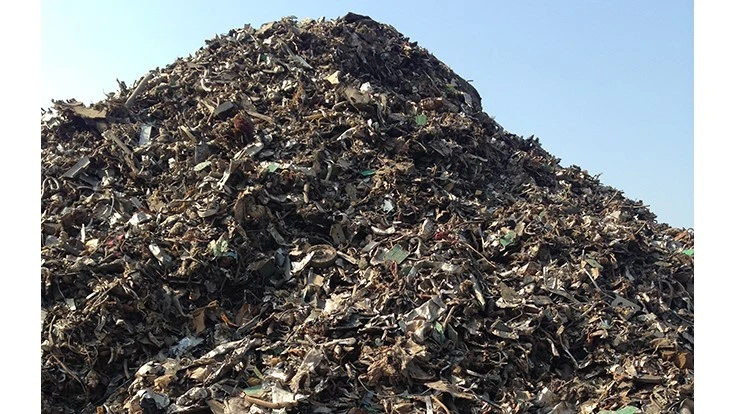
Photo by Recycling Today staff.
Steel mill scrap buyers in the United States paid more than $600 per ton on average for shredded scrap from March 20 to April 19, according to the Raw Materials Data Aggregation Services (RMDAS) of Pittsburgh-based MSA Inc.
While shredded scrap’s value eased upward by $5 per ton and prompt grades gained an incredible $73 per ton in additional value, mill buyers paid less, on average, for the No. 1 heavy melting steel (HMS) grade.
A scrap trader contacted by Recycling Today this week predicts the nearly $20 drop in value for No. 1 HMS in the RMDAS April buying period may be a sign of things to come in May. “We feel the market will be down $40 to $50 per ton next month on obsoletes and [will be] level on primes,” he says of his own company’s informal market research.
A level market on prime grades would still have it being worth some $776 per ton on the spot market, per the most recent RMDAS U.S. average. The grade remains in tight supply, and demand is high in the U.S. and elsewhere.
Three different processors or traders tell Recycling Today in April that obsolete scrap flows have been steady to rising thanks to higher scale prices and (in most places) better spring weather.
“After a winter lull, flows have rebounded nicely in our area in March and into April,” a processor in the Mid-Atlantic region comments.
A Midwestern processor characterizes flows as “very good” as of mid-April, and a scrap buyer in the Southeast remarks, “April saw good supply, weaker demand–especially for cut grades—and a lesser export market.”
With the American Iron and Steel Institute (AISI) reporting stable mill output and capacity rates in the U.S., the export situation remains a wild card in the obsolete scrap market.
Overseas mills in Turkey, the Indian subcontinent and even Mexico (a large buyer of Russian steel slabs) are scrambling to understand and work around the impacts of steel output interruptions in Ukraine and U.S. sanctions on Russia following that nation’s invasion of its neighbor.
Both the processor in the Midwest and the Southeast point to the ripple effects of the inability of Russian pig iron to make it to many of its former destinations. “The majority of open market pig iron comes from Ukraine and Russia,” the southeastern processor says. “Many rolling mills also counted on those two countries to provide billet and finished steel. This has shifted demand onto Turkey and other Mediterranean steel producers,” which leads to more scrap demand.
The processor also points out, however, that the overall disruption “has created an energy shortage that is having an impact on those same steel producers.”
In the third week of April, Davis Index is describing Turkish mill overseas scrap buying as “restrained.” The metals information service says in an April 20 news item, “Most mills [are] refraining from buying imported material or even bidding for material in anticipation of achieving lower prices [for] May and June shipments.”
As of April 20, the most recent HMS 1&2 bulk cargo booked FOB (freight on board) from the port of New York traded at $574.75 per ton, down 2.3 percent from the previous booking, according to Davis Index.
In the domestic economy, trade groups representing the nation’s largest users of steel have been remarking on the metal’s rising price throughout the pandemic recovery months of the past year and a half. They are among those who see a definite tie-in to larger concerns about inflation.
In an early April blog post, John G. Murphy of the Washington-based U.S. Chamber of Commerce says that group’s 2018 prediction that steel tariffs imposed then would “directly harm American manufacturers” were on target. “All of that came to pass,” writes Murphy.
Advocating further rollbacks on Section 232 tariffs, Murphy states, “In addition to these soaring prices, analysts say widespread steel shortages loom. Steel-consuming industries represent about half of all U.S. manufacturers.”
A 2021 comment from Cleveland-Cliffs CEO Lourenco Goncalves could serve as a rejoinder from the steel industry. He said it was about time that “a ton of steel is worth more than a ton of bananas.”
Get curated news on YOUR industry.
Enter your email to receive our newsletters.
Latest from Recycling Today
- OnePlanet Solar Recycling closes $7M seed financing round
- AMCS launches AMCS Platform Spring 2025 update
- Cyclic Materials to build rare earth recycling facility in Mesa, Arizona
- Ecobat’s Seculene product earns recognition for flame-retardant properties
- IWS’ newest MRF is part of its broader strategy to modernize waste management infrastructure
- PCA reports profitable Q1
- British Steel mill subject of UK government intervention
- NRC seeks speakers for October event







